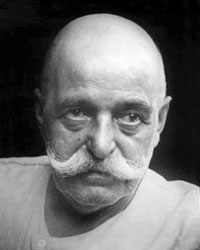
Photographer Unknown

1924. Photographer Unknown
Erowid Character Vaults
George Ivanovitch Gurdjieff
1877 (1866,1874) - Oct 29, 1949
Summary
George Ivanovitch Gurdjieff was born in Alexandropol (Gyumri), Armenia to a Greek father and Armenian mother. Although his passport listed his date of birth as Nov 28, 1877, Gurdjieff's own reports of his age and the events of his life point to an earlier date, perhaps 1866. While he was still a boy his family moved to the nearby town of Kars, where he studied with the dean of the Russian military cathedral who, with Gurdjieff's own father, became an important influence on his development. According to Gurdjieff, these two men were chiefly responsible for the early arousal of an "'...irrepressible striving' to understand clearly the precise significance, in general, of the life process on earth of all outward forms of breathing creatures and, in particular, of the aim of human life in the light of this interpretation." (The Gurdjieff Work)
Gurdjieff became a teacher, mystic, and philosopher with a following that survived long after his death. In 1919 he founded the Institute for the Harmonious Development of Man in Tiflis, Georgia which was reestablished at Fontainebleau, France in 1922. Gurdjieff believed that his ideas needed to be rediscovered in the experience of the pupil. This made for experiential teachings rather than the monastic contemplation taught by other movements of the time. He also taught a type of choreographed dance alternately called "Sacred Gymnastics" or "Movements".
Several of his students, including P.D. Ouspensky, Alexandre and Jeanne de Salzmann, Alfred R. Orage, and Thomas and Olga de Hartmann were key to the creation and recording of Gurdjieff's work, and to its spreading throughout America and Europe.
Gurdjieff became a teacher, mystic, and philosopher with a following that survived long after his death. In 1919 he founded the Institute for the Harmonious Development of Man in Tiflis, Georgia which was reestablished at Fontainebleau, France in 1922. Gurdjieff believed that his ideas needed to be rediscovered in the experience of the pupil. This made for experiential teachings rather than the monastic contemplation taught by other movements of the time. He also taught a type of choreographed dance alternately called "Sacred Gymnastics" or "Movements".
Several of his students, including P.D. Ouspensky, Alexandre and Jeanne de Salzmann, Alfred R. Orage, and Thomas and Olga de Hartmann were key to the creation and recording of Gurdjieff's work, and to its spreading throughout America and Europe.
Author of (Books)
Writings & Info
Offshoot Organizations

